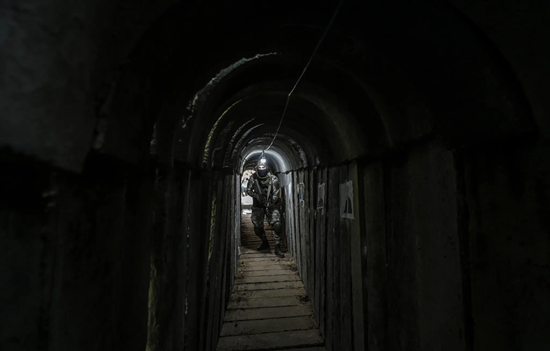The Daily Escape:

Halloween Abbey Road Tribute via The Loft
Wrongo said to a few commenters that he would follow up his “Proportionality in Gaza” column with additional information on the Gaza tunnels. How Israel deals with the Hamas tunnels is at the center of the question of proportionality since they are located under heavily populated parts of Gaza City.
As we know, more than 2 million people live in Gaza, and while many of them likely sympathize with Hamas, the best estimates of how many Hamas fighters are in the Gaza strip is around 35-40,000, a tiny fraction of the total population.
So the question is how to deal with Hamas without excessive civilian casualties, when Hamas can hide in tunnels under the city?
Before we begin, Wrongo has questions. Israel’s military confirmed over the weekend that Israel has twin goals: Annihilating Hamas while simultaneously rescuing some 230 hostages abducted from Israel on Oct. 7. But how does Israel expect to negotiate a hostage release from a group that Israel says they are annihilating? Doesn’t the threat of annihilation mean that Hamas will never release hostages to their sworn enemy? Worse, the hostages are believed to be hidden in Hamas’ tunnel network. The current heavy bombing raises the prospect of unmitigated chaos for both Palestinian civilians and hostages alike. It seems to Wrongo that Netanyahu’s twin goals are in opposition to each other.
Back to the tunnels. Lets start with the ground they are built in. We in the west have heard about Palestinian smuggling tunnels collapsing. Those were in the south near the border with Egypt, built in sandy soil. The Hamas tunnels in the Gaza Strip region are composed of limestone and sandstone along with some clay. These soils allow for digging tunnels that aren’t as subject to collapse:

Via the NYT: The network is by now so established that Hamas can manufacture weapons underground. Photo by Mohammed Saber/EPA, via Shutterstock.
The NYT reports that a few of Hamas’ recent tunnels actually begin several meters out in the Mediterranean Sea. But the majority of them are part of a network of subterranean pathways, rooms, cells and even tracks for moving carts containing weaponry. Hamas, which oversees Gaza, is believed to hide weapons, fighters and even command centers in their warren of underground chambers.
Here is an example from the WaPo:
“A decade ago, Israeli authorities discovered a tunnel from Gaza into Israel 1.5 miles long and 66 feet underground. They estimated that it had cost some $10 million and required 800 tons of concrete. But Hamas directed most of its tunnel-building effort on the land beneath Gaza, rather than at the border…”
More:
“Though no exact figures regarding the tunnels’ scale exist, experts say Hamas could control about 300 miles of tunnel….Most of the tunnels are about 150 feet deep…about the length of a 14-story building. But the network is winding, uneven and in some parts fashioned in a zigzag pattern to evade Israeli detection.”
Let’s turn to the challenges posed by any attempt to clear the tunnels of Hamas fighters. Combat inside tunnels is incredibly difficult and requires a specific skill set. The standard infantry tactics and weaponry are often not suitable inside a subterranean setting. It’s difficult to execute offensive operations inside the tunnels because navigation and communication systems often don’t work so far underground, and even night-vision goggles struggle, as they require ambient light.
The NYT quotes Gen. Joseph L. Votel, former leader of the US Central Command responsible for the Middle East who visited a tunnel controlled by the Lebanese militia Hezbollah near Israel’s border:
“This wasn’t just holes in the ground, it was an architecture….They were linked to rooms and built in a way to withstand strikes to the surface…. We should have no illusions about how this is going to be….It will be bloody, brutal fighting.”
But since the tunnels are so integral to Hamas’s operations, dismantling the tunnel network must be equally integral to Israel’s stated goal of eradicating Hamas. This is the proportionality dilemma. Will Israel be willing to forego their bombing and begin destroying tunnels primarily with the forces they have trained for the task? Or will the bombing of Gaza continue unabated? The Economist estimated that by day 18 of the war, Israel had destroyed about 9% of the buildings in Gaza.
An Israeli military unit called Samur, or weasel, specializes in underground warfare, training on mock tunnels in Israel. One Israeli technique, called “purple hair,” has been used to locate the tentacles of a Hamas tunnel. Israeli troops drop smoke grenades into a tunnel, and then watch for purple smoke to come out of buildings in the area. The smoke signals that a house is connected to the tunnel network and must be sealed off before soldiers descend into the tunnels.
However, even if Israel’s “tunnel rats” make headway, Hamas, by taking the hostages underground and releasing them over time, could extend this conflict for months, possibly years. Judging by Hamas’ 10+ yearlong preparation, they seem ready to fight to the last surface-dwelling Palestinian.
The strategic choice seems clear: If Netanyahu wants to get to eliminate Hamas, or at least its ability to wage war, he will have to send the IDF into the tunnels after them, or bomb Gaza into dust. The IDF knows this, but how many of them have the steel to venture into the darkness for months at a time?
And is eradicating Hamas even possible? Wrongo is old enough to remember the US effort to eradicate the Taliban, only to find them back in power on the day we left Afghanistan. And when, not if, Israel withdraws, then what? Who will step in to fill the power vacuum? What confidence can Israelis have that whatever replaces Hamas will be willing to live in peace with Israel?
Biden should be telling Netanyahu to stop the wholesale bombardment of Gaza and concentrate on securing the known tunnel entrances and sending in the tunnel rats. Hamas may blow up some of the tunnels as they’re penetrated causing loss of life to both sides. Then, the IDF must keep finding more tunnel entrances and keep burrowing.
Biden also should be telling Netanyahu to allow humanitarian aid to flow to the Gazans, not just from Egypt, but from the Israeli side as well.
This strategy is fraught with risks. But it contains both the moral costs and military costs for Israel and preserves the possibility of a peaceful coexistence at some point in the future. But the question is: Do the Israelis have the will and the ability to execute such a strategy successfully?
For today’s Monday Wake Up, all sides in the Hamas/Israel war need to rouse themselves from their efforts at what Netanyahu called his “Mighty Vengeance”. This war will certainly get worse before it gets better. And maybe it won’t get better in what remains of Wrongo’s lifetime. As the NYT’s Nick Kristoff said:
“Israel faces an agonizing challenge: A neighboring territory is ruled by well-armed terrorists who have committed unimaginable atrocities, aim to commit more and now shelter in tunnels beneath a population of more than two million people. It’s a nightmare. But the sober question must be: What policies will reduce the risk, not inflame it, while honoring the intrinsic value of Palestinian life as well as Israeli life?”
To help us wake up, watch and listen to the late Eva Cassidy along with the London Symphony Orchestra perform the seasonally appropriate “Autumn Leaves”. She had a voice that will never die:

As much as I have had hope for a “moderation” of Israel’s behavior in response to our president’s wise counsel and vigorous (though wisely moderated) engagement, Wrongo lays out in cold-eyed terms the range of barriers to achievement of seeming incompatible goals. It looks to me that neither of the main goal is likely to be fully achieved, thus leaving the situation ante largely in place. Plus la change….?
That said, I think the real hope lies in the possibility of multi-national brokered arrangements after whatever this turns out to be.